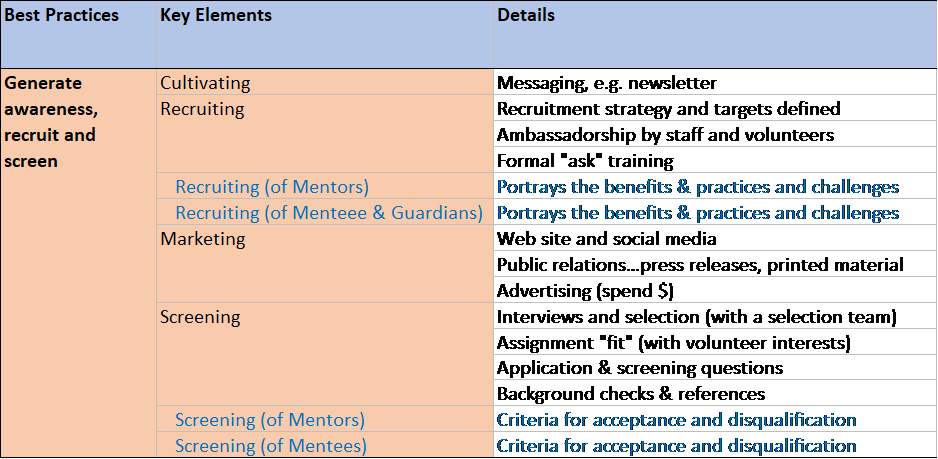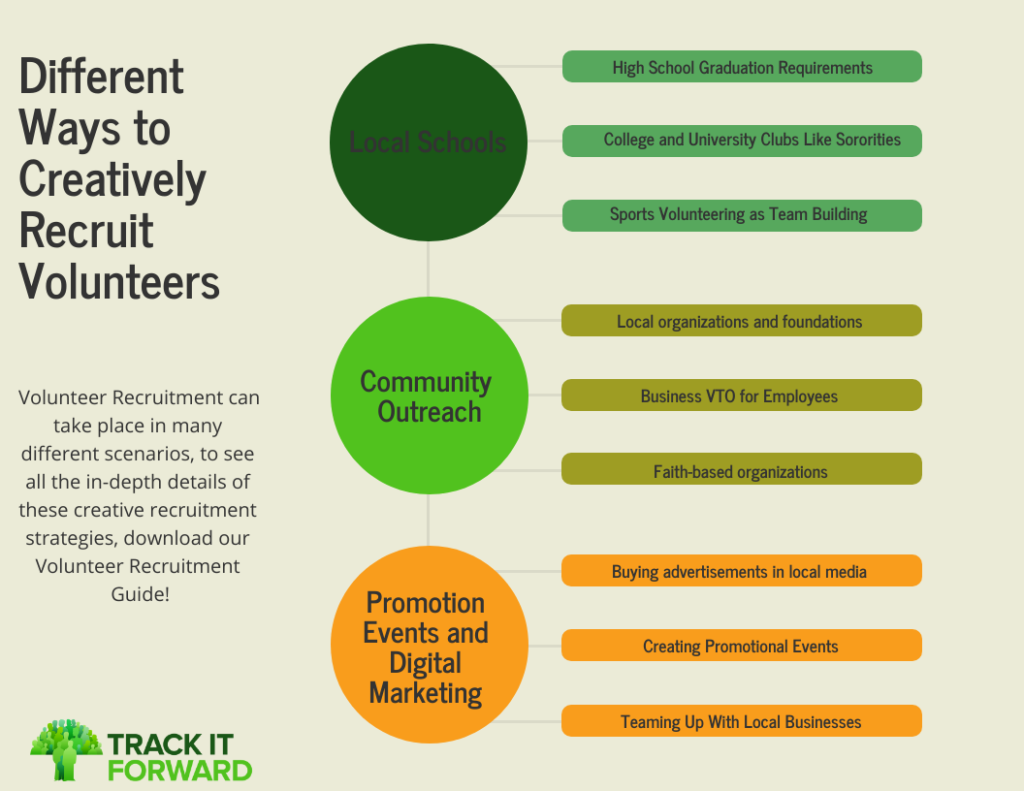This page introduces the Ambassadorship Toolkit. It is intended to EQUIP local organizations to find volunteer mentors including resources and tools.
Guiding Principles:
- Recruiting is everyone’s responsibility. It takes the board, staff and volunteers to grow a targeted list.
- Recruiting is guided by a strategy and supported by a plan and tools with the ability to measure and track progress.
- Ongoing recruitment is essential to your mission. It is not a one-time thing.
- Be creative and persistent. Make specific “asks” to targeted people.
- A personal approach is most effective.

Preparing to Recruit:
- Equip the Volunteer Leader. The volunteer leader must have the time, support, encouragement and expectations of the Board and Staff. He or she must have the skills to plan and communicate to the community and to individual targeted volunteers.
- Develop a Recruiting Strategy. A recruiting strategy defines “where to hunt”. Volunteer recruiting in general and mentor recruiting specifically is a critical and time-consuming process. It is important to have a well-documented and tested strategy and process. Tactical recruiting will leverage social media, speaking events and volunteer fairs. Strategic recruiting considers organizational partnerships and a formal ambassadorship program.
- Tell your Organizational Story. Share the the “why” behind your mission. Telling a story might cause people “to cry” and connect emotionally. Know and develop the personal stories of some clients; share your overall impact with “impact” measures; talk about your uniqueness.
- Set Goals. Set goals that match the organization’s growth plan. Consider having 10-20% more mentors than mentees as a buffer. Define numerical goals by month or quarter.
- Identify the potential barriers to recruitment? There are many barriers including competing opportunities for volunteers, your location or client-type. For each barrier, know how you will respond.
- Money. Develop the budget to match your plan.
- Work with disciplined action. A good plan will not come to fruition without action, review and corrections. Ensure there is a monthly process to review results with the Executive Director or Volunteer Committee.
Recruitment Methods:
- Making the Ask.
- How to Ask Anyone for Anything. Asking someone for a donation, or to come to an event, on behalf of your school, church, or non-profit need not be a harrowing affair. Making an ask can even be (gulp!) a pleasant and enjoyable experience. The three important areas to consider in making an ask are: relationships, planning, and process. Source: The Fundraising Authority.
- Sample script
- Requirements and expectations
- Targeting
- How to Build Your Prospect List. If you’re raising money for any type of non-profit, either as a board member, event host, or volunteer, your first task is to build a strong prospect list. A prospect list is a map of your donor universe. It answers the question, “who might want to give to this non-profit?” Source: The Fundraising Authority.
- Branding/Key Messaging. Messaging is accomplished via videos, photos, print materials, words and stories.
- Flyers. A flyer is colorful and descriptive 1 or 2 page summary of your program and recruitment story. It can be printed or electronic. Here are some examples: Flyer Example #1. Especially note the sections on “why mentor” and “does mentoring really work”. Flyer Example #2. Flyer Example #3.
- Sources of Volunteers. There are many sources of volunteers including presentations (businesses, colleges, neighborhood groups, etc.), personal outreach, events such as a volunteer fair, partnerships (organizations with similar mission but not mentoring organizations), current mentors, churches, senior groups, civic clubs, Young Professional organizations, newspapers and public service announcements.
- Discover Volunteer Sources. Finding the right skills-based volunteer is typically a more involved process than finding a hands-on volunteer. You’re not just looking for an alignment of availability, but also an alignment of expertise, perspective, and interest. Don’t let this intimidate you – there are several common sources of pro bono support, which will simplify your search for the right volunteer. If you feel you need additional guidance to land a volunteer that suits your needs, you might also consider leveraging a Volunteer Recruiter to support you with this process. Source: CapacityCommons.org.
- Communication of the Need. Make sure your needs are know in the “basic” channels including Facebook, VolunteerMatch and Cincinnati Cares.
Ambassadorship: An ambassador is someone who advocates on behalf of an organization to create goodwill and support. An ambassador should encourage donations, volunteering and agency and employer partnerships. It is a “role within a role”. Ambassadorship occurs at two levels: 1) assigned to a target group as a “relationship manager”, 2) assigned to an individual, e.g. a name received at point of entry event.
Ambassadorship can be a formal or informal process that encourages key stakeholders to give. Stakeholders could be the Board, Staff, volunteers or clients. Giving could be money, time or talent.
Ambassadorship Toolbox:
Other Resources:
- Effective Mentor Recruitment. This 82-page PDF was prepared by the US Dept. of Education and contains the following chapters:
- Chapter 1. Guiding Principles of Effective Mentor Recruitment
- Chapter 2. Preparing to Recruit
- Chapter 3. Recruitment Methods
- Chapter 4. Making a Recruitment Plan
- Mentoring Toolkit. This 39-page PDF was prepared by the Army Educational Outreach Program.
- Role Descriptions
- Mentor Role Description. The role description should contain the time commitment expectation, the desired personal attributes, safety needs and other requirements, e.g. transportation or training.
- Other Role Descriptions can be found at this link including the Volunteer Leader and Mentor Program Leader.
- Recruiting Best Practice Elements. Click here to learn more. This two-page tool is from the LSN Toolbox. Contact us if you’d like to schedule a facilitated assessment.


Other Tools:
- Sample e-mails (introductory, follow up, referral, etc.)
- Social media samples
- “Making the ask” script
- Other communication pieces like press releases, impact stores, etc.

Recruiting Senior Adults:
Recruitment of seniors can be rewarding because of their life experience and potential time availability (if retired).
- Is there a fit with our organization?
- Are there barriers that we need to overcome?
- Do we have an appealing message?
- What groups can we identify?
- Partner organizations?
